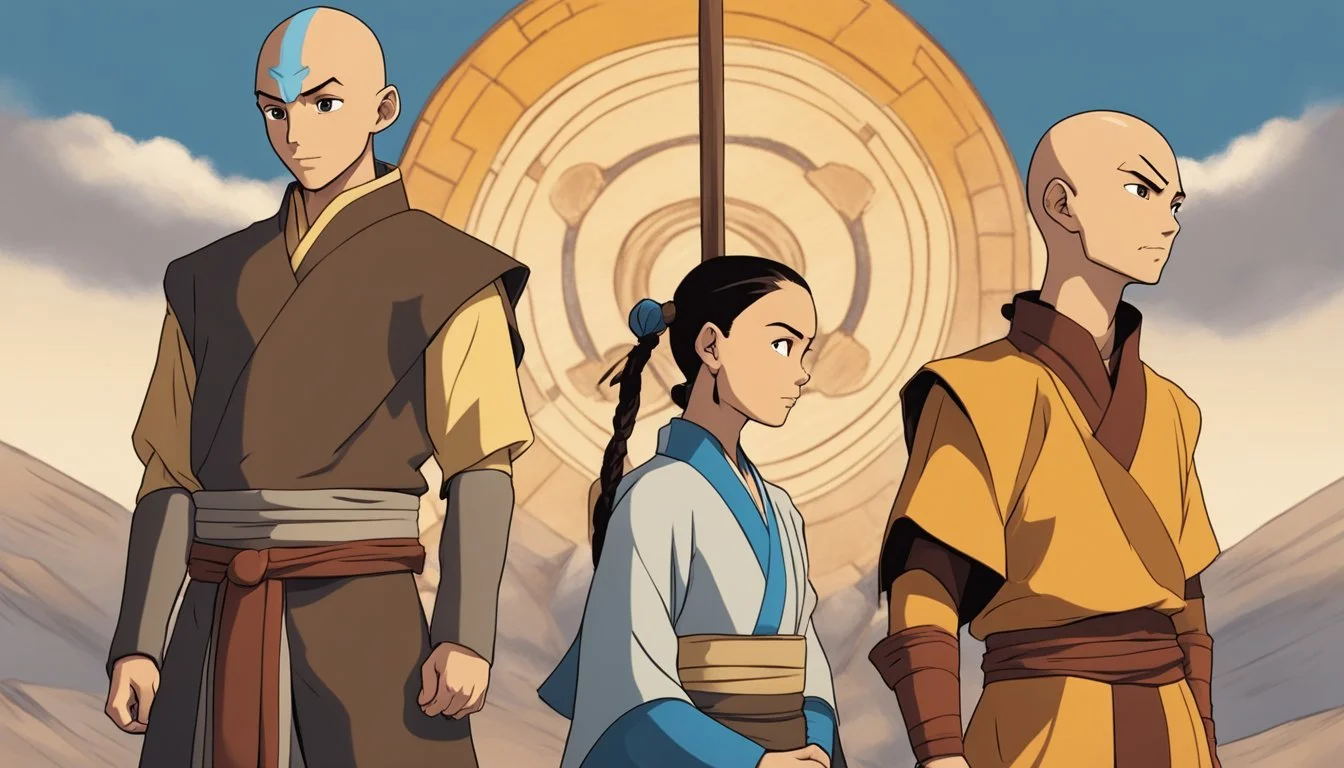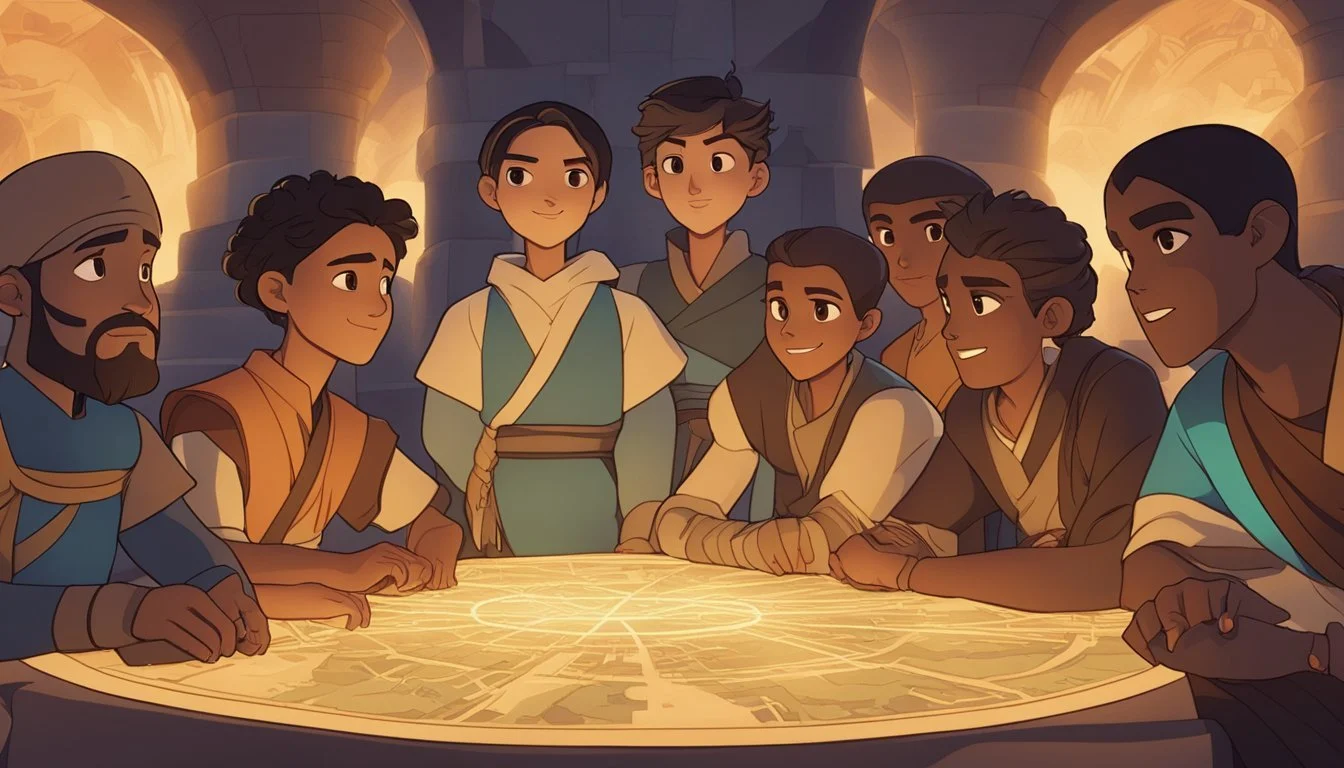Exploring ATLA Personality Types: Unpacking the MBTI of Your Favorite Characters
Avatar: The Last Airbender captivates audiences with its diverse cast of characters, each exhibiting unique personality traits. The Myers-Briggs Type Indicator (MBTI) offers an intriguing framework to analyze these beloved figures from the animated series. By applying MBTI principles to ATLA characters, fans can gain deeper insights into their motivations, strengths, and interpersonal dynamics.
The four nations of Earth, Fire, Air, and Water in the Avatar universe align interestingly with certain MBTI preferences. For instance, the grounded and practical nature of Earthbenders often corresponds with Sensing types, while the adaptable and free-spirited Airbenders may embody characteristics of Intuitive types. This correlation adds an extra layer of depth to character analysis and enhances viewers' understanding of the show's world-building.
Exploring ATLA personality types through the MBTI lens not only enriches fan discussions but also provides a relatable way for viewers to connect with their favorite characters. From Aang's ENFP exuberance to Zuko's complex ISFP journey, the series offers a rich tapestry of personalities that mirror the diversity found in real-life individuals.
Overview of Myers-Briggs Type Indicator
The Myers-Briggs Type Indicator (MBTI) is a widely used personality assessment tool. It categorizes individuals into 16 distinct personality types based on psychological preferences and cognitive functions.
History of MBTI
The MBTI was developed by Katharine Cook Briggs and her daughter Isabel Briggs Myers in the 1940s. Their work was inspired by Carl Jung's theory of psychological types. Jung proposed that people experience the world through four main psychological functions: sensing, intuition, thinking, and feeling.
Briggs and Myers expanded on Jung's ideas to create a practical assessment tool. They aimed to help people better understand themselves and others. The MBTI became publicly available in 1975 and quickly gained popularity in various fields.
Cognitive Functions in MBTI
MBTI is based on four cognitive function pairs:
Extraversion (E) vs. Introversion (I)
Sensing (S) vs. Intuition (N)
Thinking (T) vs. Feeling (F)
Judging (J) vs. Perceiving (P)
These functions combine to form 16 personality types. Each type is represented by a four-letter code (e.g., INTJ, ESFP). The dominant function shapes a person's core personality traits.
Sensing and intuition relate to how people gather information. Thinking and feeling describe decision-making processes. Judging and perceiving indicate how individuals approach the external world.
MBTI in Popular Culture
The MBTI has gained significant traction in popular culture. Many businesses use it for team building and personal development. Educational institutions employ it to help students understand their learning styles.
Online platforms offer free MBTI-inspired tests, making the concept accessible to a wider audience. Social media discussions often involve people sharing and comparing their MBTI types.
Critics argue that the MBTI lacks scientific validity. Proponents value its insights into personal preferences and interpersonal dynamics. Despite debates, the MBTI remains a popular tool for self-discovery and understanding others.
ATLA Characters and Their Alignments
The characters in Avatar: The Last Airbender display diverse personality types that shape their actions and relationships. Each character's unique traits contribute to the rich tapestry of the show's narrative and character development.
Aang and ENFP
Aang, the Avatar, embodies the ENFP personality type. His enthusiastic and imaginative nature shines through in his approach to problem-solving. Aang's optimism and ability to see potential in others reflect key ENFP traits.
As an ENFP, Aang is driven by his values and desire for harmony. This is evident in his reluctance to harm others, even his enemies. His adaptability allows him to learn bending techniques quickly and connect with people from various backgrounds.
Aang's spontaneity and love for fun often clash with the serious nature of his Avatar duties. This internal conflict showcases the ENFP struggle between personal freedom and responsibility.
Katara and ESFJ
Katara, a waterbender from the Southern Water Tribe, displays classic ESFJ characteristics. Her nurturing nature and strong sense of duty make her a pillar of support for the group.
As an ESFJ, Katara is highly attuned to others' emotions. She often takes on a caretaker role, looking after her friends' physical and emotional needs. Her strong moral compass guides her actions, sometimes leading to conflicts when others don't meet her high standards.
Katara's practicality balances out Aang's idealism. Her organizational skills and attention to detail complement the group's more carefree members. Her loyalty and commitment to her loved ones are typical ESFJ traits that drive many of her decisions throughout the series.
Sokka and His Ingenious ESTP
Sokka, Katara's brother, exemplifies the ESTP personality type. His quick wit, adaptability, and practical approach to problems make him an invaluable member of Team Avatar.
As an ESTP, Sokka thrives in high-pressure situations. His ability to think on his feet often saves the group from danger. His logical mindset and strategic planning balance out the more intuitive approaches of his companions.
Sokka's sense of humor and love for sarcasm are typical ESTP traits. These characteristics help lighten tense moments and boost team morale. His pragmatism sometimes clashes with the more idealistic views of others, but it often proves crucial in grounding the team's plans in reality.
Toph and the ISTP Perspective
Toph Bei Fong, the blind earthbending prodigy, embodies the ISTP personality type. Her direct, no-nonsense approach and incredible problem-solving skills stem from her ISTP traits.
As an ISTP, Toph excels in hands-on learning and practical applications of her skills. Her mastery of earthbending and invention of metalbending showcase her ability to push boundaries and think outside the box.
Toph's independence and disregard for social norms are typical ISTP characteristics. Her blunt honesty sometimes causes friction but also provides valuable insights. Her logical thinking and ability to remain calm under pressure make her an essential member of the team.
Zuko's Growth as an INFJ
Prince Zuko's character arc brilliantly illustrates the growth of an INFJ personality type. His journey from antagonist to ally showcases the INFJ's capacity for personal transformation and deep introspection.
As an INFJ, Zuko is driven by a strong sense of purpose and idealism. His initial misguided quest to capture the Avatar stems from his desire to fulfill what he believes is his destiny and regain his honor.
Zuko's ability to see beyond surface appearances and understand complex motivations is a key INFJ trait. This skill eventually leads him to question his own beliefs and actions, culminating in his decision to join Team Avatar.
Iroh: The Wise Mentor of ENTJ
General Iroh, Zuko's uncle, represents a mature and balanced ENTJ personality type. His strategic mind, leadership skills, and ability to see the big picture make him an invaluable mentor and ally.
As an ENTJ, Iroh excels at long-term planning and understanding complex systems. His mastery of firebending and his role in the Order of the White Lotus showcase his strategic capabilities.
Iroh's wisdom and patience in guiding Zuko reflect the growth potential of ENTJs. His ability to balance decisiveness with empathy and understanding makes him a respected figure throughout the series.
Azula's Complex ENTJ
Princess Azula, Zuko's sister, presents a darker version of the ENTJ personality type. Her strategic brilliance and leadership skills are undeniable, but they're often used for manipulation and control.
As an ENTJ, Azula excels at planning and execution. Her ability to anticipate others' moves and exploit weaknesses makes her a formidable opponent. Her charisma and confidence allow her to command loyalty, even from those who fear her.
Azula's perfectionism and inability to accept failure are exaggerated ENTJ traits. Her eventual breakdown showcases the potential pitfalls of an unbalanced ENTJ personality, highlighting the importance of emotional intelligence and self-awareness.
The Reliable ISFJ: Suki
Suki, leader of the Kyoshi Warriors, embodies the ISFJ personality type. Her loyalty, practicality, and nurturing nature make her a dependable ally and friend.
As an ISFJ, Suki is deeply committed to her responsibilities and the people she cares about. Her dedication to protecting her village and later joining Team Avatar showcases her sense of duty.
Suki's attention to detail and traditional values are typical ISFJ traits. Her combat skills and leadership abilities demonstrate how ISFJs can excel in roles that align with their values and allow them to care for others.
Mai's ISTJ Resilience
Mai, Azula's childhood friend, displays classic ISTJ characteristics. Her calm demeanor, loyalty, and practicality make her a stabilizing force within her group.
As an ISTJ, Mai values tradition and order. Her skills with throwing knives demonstrate her dedication to perfecting her craft. Her dry wit and seemingly emotionless exterior hide a deep loyalty to those she cares about.
Mai's eventual decision to betray Azula to save Zuko showcases the ISTJ's capacity for standing up for what they believe is right, even at great personal cost.
Ty Lee and Her ESFP Charm
Ty Lee, the acrobat and chi-blocker, emb
Elements of Bending and Personality Types
The four elements in Avatar: The Last Airbender align with distinct personality traits. These connections reveal insights into character motivations and behaviors across the nations.
Fire Nation Characters and Extroverted Thinking
Fire Nation characters often exhibit Extroverted Thinking (Te) traits. This cognitive function emphasizes logical decision-making and efficient goal achievement. Prince Zuko demonstrates Te through his strategic pursuit of the Avatar and his later leadership as Fire Lord.
Princess Azula embodies Te at its extreme. Her ruthless efficiency and tactical brilliance stem from this function. Fire Nation citizens value ambition, power, and progress - all hallmarks of Te.
Even non-benders like Mai and Ty Lee showcase Te-influenced behavior. Their precise combat styles and goal-oriented attitudes reflect Fire Nation values.
Water Tribe and Introverted Sensing
Water Tribe members frequently display Introverted Sensing (Si) characteristics. This function focuses on past experiences, traditions, and detailed sensory information. Katara exemplifies Si through her strong connection to Water Tribe customs and her precise waterbending techniques.
Sokka, though not a bender, relies heavily on Si. His attention to detail and practical problem-solving stem from this function. The Water Tribes' emphasis on community, tradition, and adaptability aligns closely with Si traits.
Master Pakku's initial resistance to teaching Katara waterbending reflects the Si tendency to adhere to established norms. The tribe's ability to preserve their culture despite adversity showcases Si strengths.
Air Nomads and Their ENFP Traits
Air Nomads often align with ENFP (Extraverted, Intuitive, Feeling, Perceiving) personality traits. Aang embodies the ENFP's enthusiasm, creativity, and idealism. His ability to connect with people from all nations reflects the ENFP's charisma and open-mindedness.
Air Nomad philosophy emphasizes freedom, spirituality, and harmony - core ENFP values. Their non-attachment to material possessions and focus on personal growth mirror ENFP traits.
Monk Gyatso's playful yet wise demeanor exemplifies the ENFP balance of fun and depth. The Air Nomads' emphasis on meditation and spiritual enlightenment aligns with the ENFP's quest for self-understanding and meaning.
Earth Kingdom's ISTP Representation
The Earth Kingdom frequently showcases ISTP (Introverted, Sensing, Thinking, Perceiving) traits. Toph Bei Fong is a prime example of an ISTP character. Her direct communication style, adaptability, and practical problem-solving skills are quintessential ISTP traits.
King Bumi's unconventional thinking and strategic prowess reflect ISTP characteristics. The Earth Kingdom's emphasis on stability, practicality, and resilience aligns with ISTP values.
Many earthbenders demonstrate ISTP traits through their grounded nature and ability to think on their feet. The Dai Li agents' precision and tactical skills also showcase ISTP strengths, albeit in a more negative light.
The Role of Personality in ATLA Storytelling
Personality plays a crucial role in shaping the narrative and character interactions in Avatar: The Last Airbender. It influences how characters develop, resolve conflicts, and work together as a team.
Character Development and Personality Dynamics
Aang's cheerful and carefree nature contrasts with his responsibilities as the Avatar. This internal conflict drives his growth throughout the series. Katara's nurturing personality and strong sense of justice guide her actions, often leading her to take on a maternal role within the group.
Zuko's journey from antagonist to ally is deeply rooted in his complex personality. His struggle with honor and identity shapes his character arc. Toph's stubborn and direct nature challenges traditional notions of helplessness associated with blindness, showcasing her strength and independence.
Sokka's strategic mind and sarcastic wit provide both comic relief and crucial planning skills for Team Avatar. His personality traits complement the benders' abilities, highlighting the importance of diverse strengths within the group.
Interpersonal Conflict and Resolution
Personality differences often spark conflicts among characters. Toph's blunt attitude clashes with Katara's caring nature, leading to heated arguments. These conflicts serve to deepen character relationships and foster personal growth.
Zuko's interactions with Team Avatar showcase how personality-driven conflicts can evolve into understanding and cooperation. His initial hostility gives way to genuine friendship as the group learns to appreciate his complexities.
Aang's pacifist beliefs frequently conflict with the more aggressive approaches of his companions. This tension creates opportunities for meaningful discussions about morality and the nature of conflict resolution in the Avatar world.
Harmony and Cooperation Among Team Avatar
Despite their diverse personalities, Team Avatar achieves harmony through mutual respect and understanding. Aang's leadership style embraces each member's unique traits, allowing them to contribute their individual strengths to the group's goals.
Katara's empathy and Sokka's pragmatism balance each other, creating a well-rounded approach to problem-solving. Toph's directness complements Aang's tendency to avoid confrontation, pushing him to face challenges head-on.
The team's ability to leverage their personality differences becomes a key factor in their success. By recognizing and valuing each other's traits, they form a cohesive unit capable of overcoming seemingly insurmountable obstacles.
Real-World Influences on ATLA
Avatar: The Last Airbender draws inspiration from various real-world cultures and philosophies. The show incorporates elements from Asian traditions, family dynamics, and personality archetypes to create a rich, multifaceted world.
Cultural References in Bending and Characters
The bending arts in ATLA are rooted in traditional Chinese martial arts. Waterbending mirrors tai chi movements, while earthbending resembles hung gar kung fu. Firebending takes cues from Northern Shaolin kung fu, and airbending reflects ba gua zhang techniques.
Character designs and costumes also reflect diverse Asian influences. The Fire Nation's architecture and clothing draw from Japanese culture, while the Earth Kingdom incorporates Chinese elements. Air Nomads show Tibetan Buddhist influences in their attire and practices.
These cultural references extend to the show's spiritual aspects. The concept of chi and the Avatar's role as a bridge between worlds echo Eastern philosophies.
Family and Relationships in ATLA
Family dynamics play a crucial role in shaping characters' personalities and motivations. Fire Lord Ozai's abusive relationship with his children, Zuko and Azula, drives much of the plot and character development.
Katara and Sokka's strong sibling bond contrasts with the fractured relationships in the Fire Nation royal family. Their determination to protect each other and find their father highlights the importance of family unity.
The show explores various types of relationships beyond blood ties. Aang's connection to his Air Nomad mentors and his found family in Team Avatar demonstrate the value of chosen bonds. Iroh's paternal relationship with Zuko offers a positive example of mentorship and unconditional love.
These family and relationship portrayals resonate with viewers, reflecting real-world experiences and personality types. The characters' interactions and growth throughout the series mirror the complex dynamics found in many families.
Legacy of ATLA in Media
Avatar: The Last Airbender has left an indelible mark on popular culture, shaping animation and storytelling for years to come. Its impact extends far beyond its original run, inspiring countless creators and maintaining a dedicated fanbase.
Influence on Animation and Storytelling
ATLA revolutionized Western animation with its serialized storytelling and complex character arcs. The show's blend of Eastern and Western influences created a unique visual style that many subsequent series emulated. Its mature themes and nuanced exploration of war, redemption, and personal growth raised the bar for children's programming.
The series' success paved the way for more ambitious animated projects targeting both young and adult audiences. Many animators and writers cite ATLA as a major inspiration for their work, praising its world-building and character development.
Fan Works and Continued Popularity
ATLA's passionate fanbase has kept the series alive through various forms of fan-created content. Fan art, fanfiction, and cosplay communities continue to thrive, with new works constantly emerging. Popular fan works often explore alternative storylines or expand on minor characters.
The series' enduring popularity led to official expansions of the Avatar universe, including comics, novels, and spin-off series. Episodes like "Tales of Ba Sing Se" remain fan favorites, often inspiring tributes and reinterpretations within the fandom.
Online platforms have played a crucial role in maintaining ATLA's relevance, with fans sharing theories, analyses, and discussions about the show's themes and characters. This ongoing engagement has introduced new generations to the series, ensuring its legacy continues to grow.




